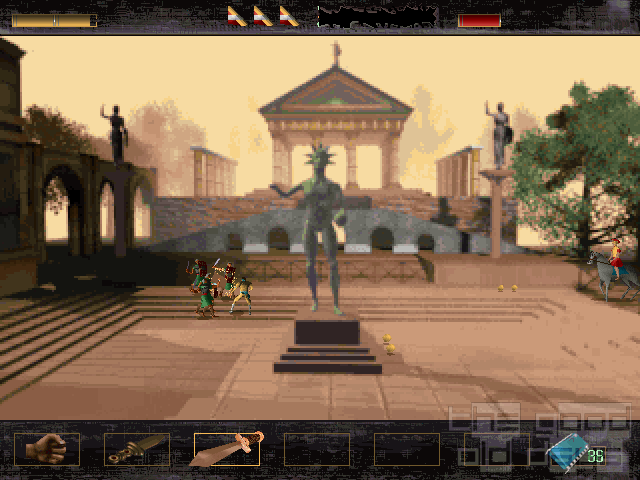In the home country of the Gameboy, the clumsy, lovable comic figure Doraemon commands a popularity comparable to the famous Mickey Mouse. This blue, cat-like robot from the future starring in many manga and anime series. His appearance in a film drew attention to the subject of environmental destruction in an amusing-moral time travel adventure as early as 1990. The Gameboy got a story-based release two years later. Therefore, a quick glance at the actual plot.
As descendants of the humans, the technically highly developed Nimge inhabit the ruined planet Earth. Evolution has also grown the animals to be intelligent, so that they were finally able to escape oppression with a starship to another planet. Soon, however, this planet was discovered and the Nimge came to conquer it. Doraemon now succeeds in jumping from the present time-line together with his friends to help the animals on their planet at this critical moment.
In case you are wondering: yes, all the texts of the small introductory scene, which presents the story, are in Japanese only. Skipping it will mean no harm and with a little imagination, the Japanese menu navigation can be easily understood. Controlling the gameplay will be intuitive on the Gameboy anyway.

As Doraemon, you wander through the Zelda-style world-map of the “Animal Planet” almost unbothered by enemies, only to stumble upon its peaceful inhabitants at times. At certain places, you can also find portals to enter various jump'n'run and shoot'em'up sections for the real action. However, access only makes sense if you have the appropriate weapon for the respective end-boss, which you get by solving smaller puzzles or after playing through certain sections. This results in a puzzle element that builds on the frequent dialogues between Doraemon, his friends and the NPCs. So, if you don't understand a single word, you will eventually go astray here.
In this respect, the game is obviously not for the common use in a broad western audience. My initial idea was to expand my Gameboy game-collection with an abstruse rarity of unknown value as I grabbed it on special offer. At this point, I wasn’t aware of Doraemon’s superstar-status in Japan and my choice could have easily been something else. But as I just had it, I wanted to invest the effort of translation, to know more about it.
There are amazing graphical effects that I have never seen before on the Gameboy: the underwater world billows like looking through the surface of a moving lake. The forbidden forest is covered with lifelike clouds of smoke. Imagery worth seeing and cut-sequences take the viewer along the intergalactic story. The final chase across skyscrapers on the planet Nimge is unforgettable, wild spaceships on your trail. The acoustic effects and the varying background music do wonders for the atmosphere.

In terms of gameplay, however, both the jump'n'run and the shoot'em'up sections are quite short, uneventful and kind of uninspired. Not a single D-pad acrobat would see any kind of challenge in this part of the game. With the right weapon, every end-boss is a piece of cake. The many 1UPs completely compensate for the one-shot death system and each level is additionally secured by a password.
Apparently, the main-focus is on the easy accessibility in order to highlight Doraemon and unfold the whole story with its short manga style dialogues. There are even 12 hidden raccoon heads – the mascot of the Epoch company – throughout the game for the particularly attentive or ambitious players to increase the long-term fun.
The overall experience of that game was finally kind of ambivalent for me. I wasn't really impressed by the dive into the Doraemon universe and the Japanese manga culture, especially since I've never been interested in comics of this style before. Instead, the Google Live translation was opening up the entire game language-wise and no unpleasantly demanding barriers were blocking my way on behalf of completing the action-levels. So, the actual act of playing was more of a pleasure in view of the diversely designed, nice-looking levels and the constant reward by noticeable progression in the story.
This is why I answer the question of whether it was worth the effort with 'yes'. However, I answer the question of whether I would buy the game again with 'no', because I was initially looking for a rarity and not a mainstream one.


Comments (1) [Post comment]